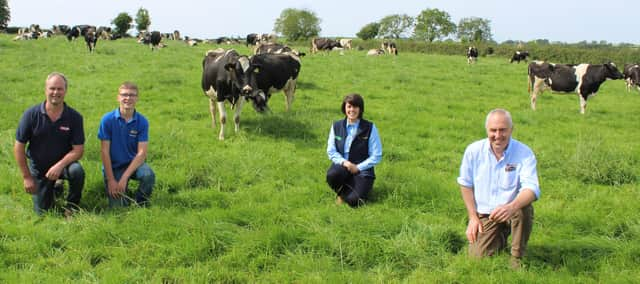Gearing-up for calving season


The majority of the 180-strong Holstein Friesian herd calve down between September and January.
John’s latest Bench Marking figures confirm the following level of performance: Yield – 9469L; Butterfat - 4.20% and Protein -3.32% on 3.7tonnes of United Feeds concentrates.
Advertisement
Advertisement
Getting the management of the cows correct during the dry period is vitally important. And for those animals calving down in the early autumn on the McNeilly farm, this means taking them indoors for the last three weeks of their seven-week dry period. They are then put on a diet comprising a high fibre, low potassium silage and 2-3kg of United Feeds Pre-Calver nuts.
John explained: “All the dry cows are in good condition at the present time and we have plenty of grass available to them. But I have had issues with milk fever and other metabolic problems in the past when trying to calve the cows at grass so, on the advice several years ago of United Feeds’ Sam Watson, I now follow the company’s pre-calver programme.
“This involves bringing the dry cows indoors and feeding them a fit-for-purpose diet. I now firmly believe this is the only way to transition early autumn calvers.
“It’s a very simple system but it works well for us. I know that the nuts contain all the minerals and vitamins the animals need to calve down successfully, and our experience confirms that the cows produce a strong calf with plenty of vitality boosted by the rich colostrum on offer. The cows are well primed and able to start their lactation in full health.”
Advertisement
Advertisement
John is equally focussed when it comes to preparing heifers for calving. He commented: “This year, the heifers will be calving down between 24 and 30 months of age. Those coming into the milking group over the coming weeks will be put on the exact same management regime as that laid out for the older cows.
“I know that heifers are less prone to problems like Milk Fever post calving. However, the great advantage of putting them on a silage and concentrate diet prior to giving birth is that it helps prepare those younger animals for the step up in dry matter intakes that will confront them once they start milking. It’s also important to provide heifers with the full complement of minerals and vitamins they need in the weeks up to calving as they themselves are still growing too.”
United Feeds’ Sam Watson and Kathryn McKeown were recent visitors to the McNeilly farm.
Sam explained that the concentrate portion of the rations fed to dry cows should compensate for the inadequacies of the forage, in terms of meeting their nutritional requirements in full.
Advertisement
Advertisement
“And, crucially, minerals play a key role in this regard. Our United Feeds Pre-Calver range has been specifically formulated to meet the many requirements of the dry cow,” he said.
“It is a market leading product with many qualities aimed at ensuring a problem free calving and early lactation.”
Key characteristics of the Pre-Calver range include specific cereal content. Starch in the diet stimulates rumen papillae to re-develop after a period of rest. In turn, this helps to prepare the rumen for the type of diet that will be fed in early lactation, thereby reducing digestive upsets. High quality proteins are also included at high rates to meet the demand of the growing calf. This approach also drives intakes during a period when appetite loss is common, while also preventing the depletion of protein reserves post calving.
Kathryn commented: “Magnesium Chloride is an integral part of our dry cow ration formulation.
Advertisement
Advertisement
“This anionic salt helps to reduce the DCAD value of the overall diet, decreasing the likelihood of clinical and sub-clinical milk fever problems from arising.
“United Feeds’ Herd Care supplement is also included in the dry cow formulation. It supplies organic minerals, essential vitamins and antioxidants. These include high levels of Vitamin E and organic selenium to reduce the risk of retained placentas and improve calf viability.
“The Herd care package has also been designed to optimise immune function and reduce somatic cell count in early lactation.”
According to Kathryn, Yea-Sacc®, Bio-Moss® and LIFT are also included in the United Feeds’ Pre-Calver range to improve rumen function, colostrum quality and liver function respectively.
Advertisement
Advertisement
She concluded: “Full details of the products and the United Feeds Pre-calver booklet can be found on the United Feeds website www.ufeeds.com or contact one of the advisory team to discuss a solution specific to your own herd situation.”